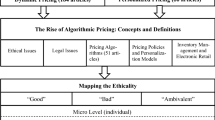Abstract
The objective of this paper is to study optimal pricing strategies in a duopoly, under an asymmetric information structure, where the appropriate solution concept is the feedback Stackelberg equilibrium. In order to take into account effects such as imitation (e.g., word of mouth) and saturation, the demand (state equation) is assumed to depend on past cumulative sales, market potential, and both players' prices. We assume also that the unit production cost decreases with cumulative production (learning effects). Each player maximizes his total discounted profit over the planning horizon.
The problem is formulated as a two-player discrete-time finite-horizon game. Existence results are first obtained under rather mild conditions. Since the solution of this problem is intractable by analytical methods, we use a numerical approach. Thus, we design a numerical algorithm for the computation of feedback Stackelberg equilibria and use it to obtain strategies in various representative cases. The numerical results presented are intented to give some insights into the optimal pricing strategies in the context of an asymmetrical feedback information structure.
Similar content being viewed by others
References
Bass, F. M., A New Product Growth Model for Consumer Durables, Management Science, Vol. 15, pp. 215–227, 1969.
Mahajan, V., and Wind, Y., Innovation Diffusion Models of New Product Acceptance, Ballinger Publishing Company, Cambridge, Massachusetts, 1986.
Robinson, B., and Lakhani, C., Dynamic Price Models for New-Product Planning, Management Science, Vol. 21, pp. 1113–1122, 1975.
Kalish, S., Monopolist Pricing with Dynamic Demand and Production Cost, Marketing Science, Vol. 2, pp. 135–159, 1983.
Kalish, S., A New Product Adoption Model with Price, Advertising, and Uncertainty, Management Science, Vol. 31, pp. 1569–1585, 1985.
Dockner, E., and JØrgensen, S., Optimal Advertising Policies for Diffusion Models of New Product Innovation in Monopolistic Situations, Management Science, Vol. 34, pp. 119–130, 1988.
Teng, J. T., and Thompson, G. L., Oligopoly Models for Optimal Advertising When Production Costs Obey a Learning Curve, Management Science, Vol. 29, pp. 1087–1101, 1983.
Thompson, G. L., and Teng, J. T., Optimal Pricing and Advertising Policies for New Product Oligopoly Models, Marketing Science, Vol. 3, pp. 148–168, 1984.
Dockner, E., Optimal Pricing in Dynamic Duopoly Game Model, Zeitschrift für Operations Research, Vol. 29B, pp. 1–16, 1985.
Feichtinger, G. M., and Dockner, E., Optimal Pricing in a Duopoly: A Noncooperative Differential Games Solution, Journal of Optimization Theory and Applications, Vol. 42, pp. 199–218, 1985.
Eliashberg, J., and Jeuland, A. P., The Impact of Competitive Entry in a Developing Market upon Dynamic Pricing Strategies, Marketing Science, Vol. 5, pp. 20–36, 1986.
Dockner, E., and JØrgensen, S., Optimal Pricing Strategies for New Products in Dynamic Oligopolies, Marketing Science, Vol. 7, pp. 315–334, 1988.
Dockner, E., and JØrgensen, S., New Product Advertising in Dynamic Oligopolies, Zeitschrift für Operations Research, Vol. 36, pp. 459–473, 1992.
Erickson, G. M., Dynamic Models of Advertising Competition, International Series in Quantitative Marketing, Kluwer Academic Publishers, Norwell, Massachusetts, 1991.
Zaccour, G., A Differential Game Model for Optimal Price Subsidy of New Technologies, Game Theory and Applications, Vol. 3, 1996 (to appear).
Simaan, M., and Cruz, J. B., On the Stackelberg Strategy in Nonzero-Sum Games, Journal of Optimization Theory and Applications, Vol. 11, pp. 533–555, 1973.
Basar, T., and Haurie, A., Feedback Equilibria in Differential Games with Structural and Modal Uncertainties, Advances in Large Scale Systems, Edited by J. B. Cruz, JAI Press, Greenwich, Connecticut, pp. 163–201, 1984.
Breton, M., Alj, A., and Haurie, A., Sequential Stackelberg Equilibria in Two-Person Games, Journal of Optimization Theory and Applications, Vol. 59, pp. 71–97, 1988.
Leitmann, G., On Generalized Stackelberg Strategies, Journal of Optimization Theory and Applications, Vol. 26, pp. 637–643, 1979.
D'Aspremont, C., Jaskold Gabszewicz, J., and Thisse, J. F., On Hotelling's Stability in Competition, Econometrica, Vol. 47, pp. 1154–1150, 1979
JØrgensen, S., Optimal Control of a Diffusion Model of New Product Acceptance with Price Dependent Total Market Potential, Optimal Control Applications and Methods, Vol. 4, pp. 269–276, 1983.
Author information
Authors and Affiliations
Rights and permissions
About this article
Cite this article
Breton, M., Chauny, F. & Zaccour, G. Leader–Follower Dynamic Game of New Product Diffusion. Journal of Optimization Theory and Applications 92, 77–98 (1997). https://doi.org/10.1023/A:1022636029501
Issue Date:
DOI: https://doi.org/10.1023/A:1022636029501




